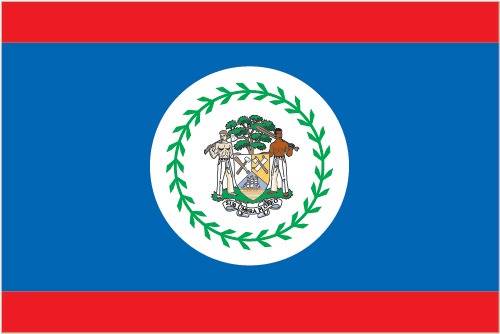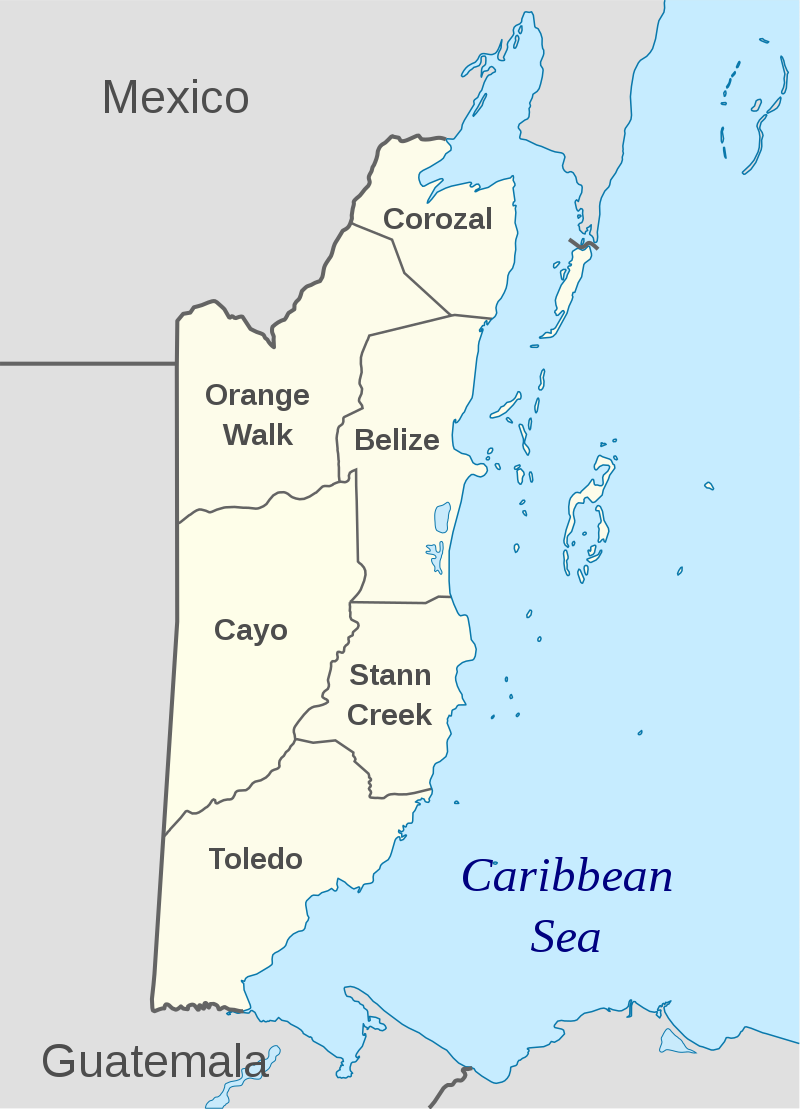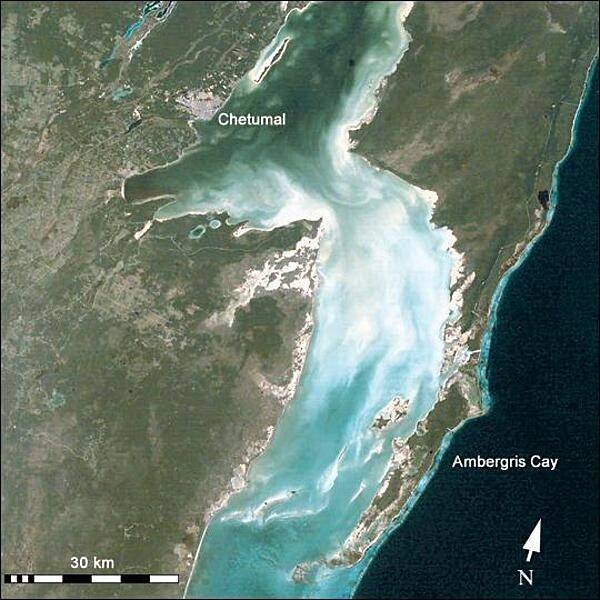8 Belize

Royal blue with a narrow red stripe along the top and the bottom edges. Centered is a large white disk bearing the coat of arms. The coat of arms features a shield flanked by two workers in front of a mahogany tree with the related motto SUB UMBRA FLOREO (I Flourish in the Shade) on a scroll at the bottom, all encircled by a green garland of 50 mahogany leaves. The colors are those of the two main political parties: blue for the PUP and red for the UDP. Various elements of the coat of arms – the figures, the tools, the mahogany tree, and the garland of leaves – recall the logging industry that led to British settlement of Belize.
Flag courtesy of the CIA World Factbook


Chetumal Bay lies on the border between Mexico and Belize. To the east of the bay, Ambergris Cay (in Belize) connects the Belize Barrier Reef to the Yucatan Peninsula (Mexico).
Photo courtesy of the CIA World Factbook
Government
According to Britannica, Belize’s government is based on the British parliamentary system. The 1981 constitution provides for a bicameral National Assembly composed of an elected House of Representatives and an appointed Senate. Members of the House and the Senate both serve five-year terms. The governor-general, a Belizean national who represents the British crown, nominally appoints the prime minister (the leader of the majority party in the House) and the opposition leader (the leader of the principal minority party). The prime minister appoints the cabinet.
Local government consists of the Belize City Council and town boards with authority over most municipal affairs. Most villages have councils, and some Mayan villages have an alcalde (a traditional community-elected leader) with limited powers. The Mennonite community administers its own form of local government.
The legal system is modeled on English common law. A chief justice heads the Supreme Court, but the Court of Appeal is the country’s highest court; both are independent of the national government. In 2001 Belize joined most members of Caricom to establish a Caribbean Court of Justice (CCJ), which was inaugurated in 2005. Civil and criminal cases that were heard in the Court of Appeal were brought before the Judicial Committee of the Privy Council, while cases regarding Caricom treaties were appealed in the CCJ. In 2009 Belize adopted the CCJ as its final court of appeal, replacing the Privy Council.
Belize Department of Civil Aviation
The Belize Department of Civil Aviation was established by the Civil Aviation Act, Chapter 239, Revised Edition 2000 of the Substantive Laws of Belize. The principal function of the Department is to regulate and administer a safe civil aviation system whilst ensuring that Belize discharges its obligations properly under international civil aviation agreements and treaties, in particular, the Convention on International Civil Aviation.
The Department of Civil Aviation is the regulatory and oversight body in all civil aviation matters in Belize. This Department is headed by the Director of Civil Aviation as established in the Belize Civil Aviation Act. After becoming a Contracting State to the Convention on International Civil Aviation in 1991, Belize is obliged to comply with the Standards and as far as practicable with the Recommended Practices contained in all nineteen Annexes to the Convention. The Department is made up of the following technical divisions: Personnel Licensing, Flight Operations, Airworthiness, Aviation Security, Air Transport, Aerodromes, Dangerous Goods, Aircraft Registration, Aircraft Accident and Incident Investigations, Search and Rescue, Air Traffic Services and Aeronautical Information Services. The main functions of the Department are to ensure the safety of air navigation and to promote and encourage the safe, orderly, and economic development of civil aviation locally, regionally, and internationally.
Airspace
SkyVector – Google Maps – ADS-B Exchange
ICAO countries publish an Aeronautical Information Publication (AIP). This document is divided into three parts: General (GEN), En Route (ENR) and Aerodromes (AD). ENR 1.4 details the types of airspace classes they chose to adopt from classes A through G.
Belize Airspace Reclassifications
The Central American Corporation for Air Navigation Services (COCESNA) is an International Organization for Central American Integration, non-profit and public service, with legal status and financial autonomy, created on February 26, 1960 and governed by a Board of Directors, which it is constituted in its highest collegiate body, which is made up of the representatives of the signatory States of its Constitutive Agreement; established with well-defined objectives and purposes to respond and jointly comply with civil aviation international commitments contracted as signatory countries of the Convention on International Civil Aviation of 1944, known as the Chicago Convention. In that order, COCESNA enjoys the exclusive rights to provide Air Traffic, Aeronautical Telecommunications and Radio Assistance services in the territories of the Member States and other services established in the regional plans that have been entrusted to it by the Contracting Parties. under an international agreement. Its operations are fundamentally based on the Standards and Methods recommended by the ICAO. The adherence to the established norms and the search for excellence constitute COCESNA’s fundamental objectives.
As a result of the notable progress in aviation at the end of the 1950s, especially with the entry into service of jet aircraft, the need to modernize and strengthen the region’s air navigation services was valued, for which, in the month November 1959, a meeting with the Directors was held in Guatemala. Generals of Civil Aeronautics of Central America at that time, within which it was agreed to convene a Diplomatic Conference aimed at establishing a specialized regional organization, with the necessary human and financial resources to meet these modern requirements, as well as to unify and coordinate regional intergovernmental efforts and actions that would benefit the users of these services. Therefore, from February 22 to 26, 1960, the V Conference of Directors of Civil Aeronautics was held in Tegucigalpa, Honduras, signing the guidelines of the Central American Corporation of Air Navigation Services -COCESNA, thus marking the beginning of its existence and operation. Consequently and by virtue of its nature, on February 1, 1961, its Constitutive Agreement was registered with the International Civil Aviation Organization – ICAO and on January 2, 1962 with the United Nations (UN). During the year 1963, COCESNA acquires the official recognition of the States of the Central American isthmus, through decrees and laws that ratified its Constitutive Agreement issued by the Legislative Assemblies of each Member State. Belize is a member state of COCESNA.
Drone Regulations
Drone application registration is available for download.
Advanced Air Mobility (AAM) Regulations & Policies
None found by the author.
However, should you, the reader, happen to stumble across something to the contrary, please email the author at FISHE5CA@erau.edu and you may be mentioned in the ACKNOWLEDGEMENTS section of this book by way of thanks for contributing to this free eBook!
Advanced Air Mobility (AAM) News
None found by the author.
However, should you, the reader, happen to stumble across something to the contrary, please email the author at FISHE5CA@erau.edu and you may be mentioned in the ACKNOWLEDGEMENTS section of this book by way of thanks for contributing to this free eBook!
Short Essay Questions
Scenario-Based Question
You have been hired by a Drone Startup Company. Your boss has immediately assigned this job to you.
They need you to prepare a one-page memo detailing the legalities of using a drone at Ambergris Cay, pictured above.
They need you to mention any national laws and local ordinances.
They specifically want to know what airspace (insert pictures) you will be operating in, and whether or not you need an airspace authorization.
Does it matter whether or not you are a citizen of the country?
Lastly, there is a bonus for you if, as you scroll through this chapter, you find any typos or broken links!
Short Essay Questions
- What are the drone categories?
- How is registration addressed?
- How is remote ID addressed?
- What are the model aircraft rules?
- What are the commercial drone rules?
- Are there waivers or exemptions to the rules? If so, for what?
- Would you share a link to an interactive airspace map?
- How is BVLOS addressed?
- How can you fly drones at night?
- How can you fly drones over people?
- Where do you find drone NOTAMs?
- What are the rules for drone maintenance?
- What are the rules for an SMS program?
- What are some unique rules not mentioned above?
- What are the C-UAS rules?
- What are the AAM rules?

